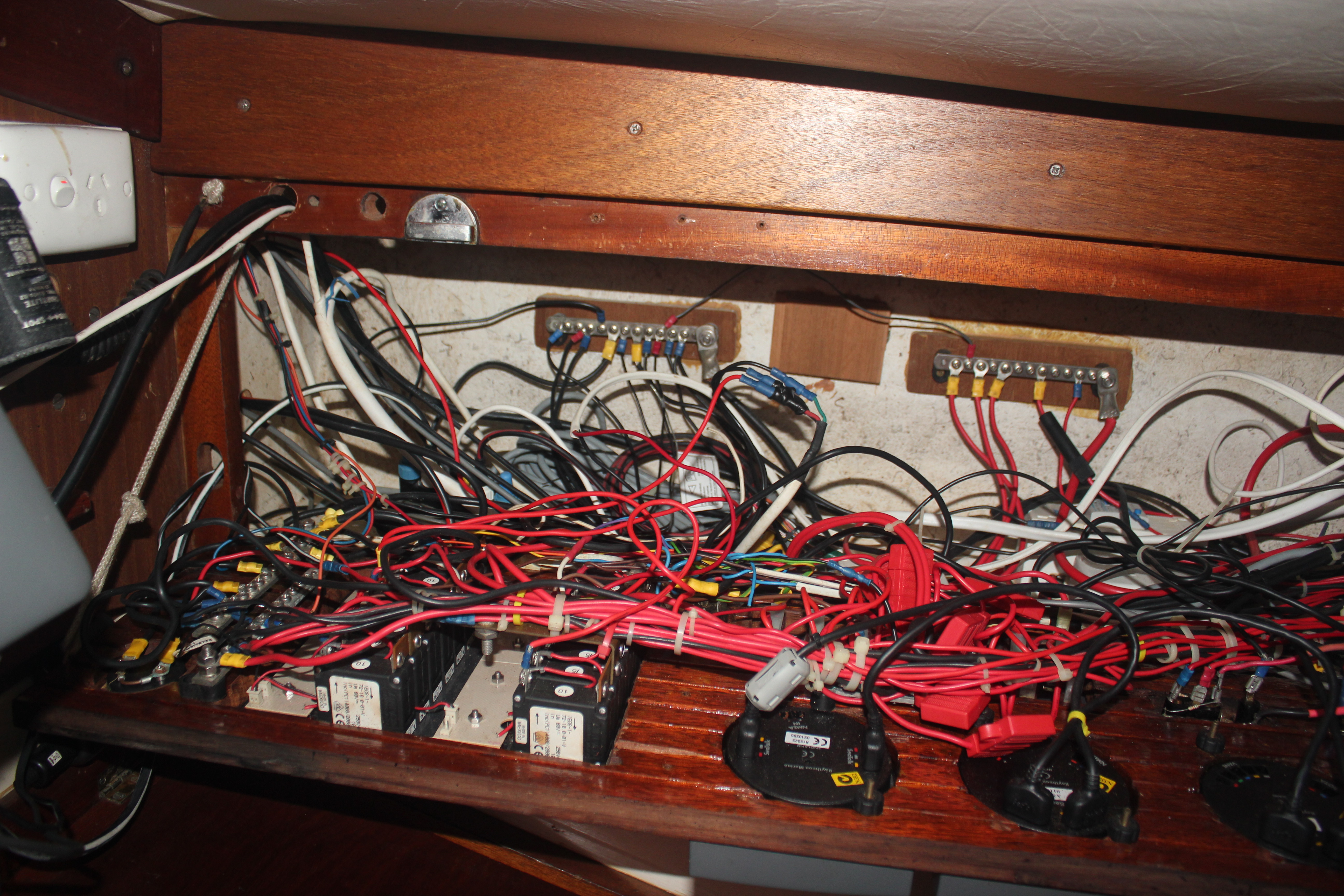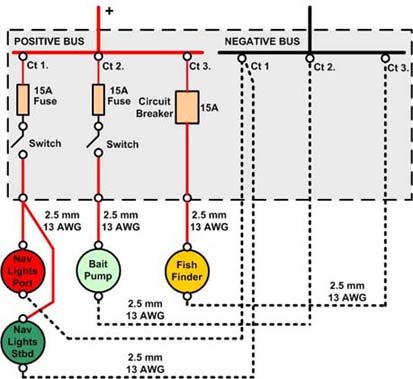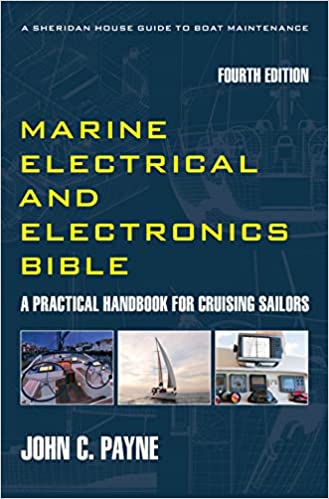Basic Boat Wiring
Basic boat wiring and installation advice. The average cruising yacht, fishing boat, motorboat and most any type of pleasure boat is now high technology. The computer technology age has taken over with many boats now having smart battery chargers, smart alternator regulators, smart battery switches, touchpad electronic switch panels and microprocessor-controlled inverters, and LED lighting, instrument networks, computers, internet and email. They all require and need a boat wiring system to support it all of this technology, and too often it falls short of the technical requirements.
The Marine Electrical Electronics Bible is now out, buy and save money, make your boat more reliable and be self sufficient.Whether you have a new cruising yacht or are buying a preloved and older used boat, or adding a new boat device the rules and recommendations remain the same. On all boats installing basic boat wiring and the boat wiring diagram are major topics of interest. The electrical power system required to supply equipment is also a misunderstood subject, and it is the foundation for reliable equipment operations. Read the pages on batteries and charging.
Basic Boat Wiring
Basic boat wiring defects are a major source of problems on boat equipment and devices of all types, as well as marine diesel engines and even your electronic controlled Mercury Marine outboard motor, and the inboard marine diesel engine. I want to change the dangerous illusion that boat and vehicle systems are similar.
As we all know, there are no 24 hour road services offshore, and safety is the prime factor, and this depends on good systems design and installation. Whether you sail and boat in France, England, Netherlands, Australia, New Zealand, Canada or the United States, the same wiring system problems are found.
Basic Boat Wiring
There are standards, rules and regulations and it is advised that you always use or consult them, in many cases to comply with your insurance requirements. In addition, well planned and installed basic boat wiring and cable installations means enhanced reliability, increased safety, and a lot less stress and drama out on the ocean. Look at the wiring image below, that is one boat I recently looked at, and the owner claimed it was installed by a professionally qualified. If you get a professional marine electrical person, make sure you sight the credentials or certification.
Basic Boat Wiring Planning
Basic boat wiring and cable installation covers many issues and considerations, along with meticulous planning. Selecting the right wiring size for each circuit is just the first stage. Then considering voltage drops is the next as you plan cable sizes. What wiring standards are you going to use, such ABYC E-11 or Recreational Craft Directive (RCD) in Europe?
It is important to make a basic boat wiring diagram and work out what goes where, how to do this? How are you going to install the wiring? Can you install wires and ensure they will not get mechanically damaged? Then how to electrically protect the wires and cable, such as fuses and circuit breakers. This all ties in with switch panels and panel boards, and the question of monitoring current and voltage and how they are connected. The subject of making wiring and cable terminations and correctly routing cables and wires clear of data and instrument cables to avoid interference. The subject of interference is a big one and must be considered when installing wires. All of these factors and subjects are explained in great detail in the much enhanced and expanded 4th Edition of the Marine Electrical and Electronics Bible. The image below is a simple basic wiring arrangement, and there variations on this.
Basic Boat Wiring Rules
Whether you have a new boat or are buying a used boat, adding a boat accessory to your fishing boat or sailing yacht, the basic marine electrical systems rules remain the same. The electrical power system required to supply equipment is usually a misunderstood subject, and it is the foundation for reliable equipment operations and is covered elsewhere.
I want to change the dangerous illusion that boat electrics and vehicle systems are similar. As we all know, there are no 24 hour road services offshore, and safety is the prime factor, and this depends on good systems design and installation. Whether it is in France, England, Netherlands, Canada, Australia, New Zealand or the United States, the same boat electrics problems are found, and the forums show that clearly.
Basic Boat Wiring Rules and Regulations
Small boat marine electrics systems should be installed as far as practicable to comply with one of the principal standards or recommendations in use, and most standards are similar or overlap although some may ask for higher standards on particular systems than others. You should consider any of the standards as the minimum level required for marine electrical installations. These include American Boat and Yacht Council (ABYC). Standards and Recommended Practices for Small Craft. The United States Coast Guard. The European Recreational Craft Directive (UK and Europe). I am sure there a few others as well, and the trend by some to treat small boat electrics as auto systems finished long ago. Great information on the up-to-date Boat Wiring Regulations. Rules and regulations have to cover a wide variety of boat types, construction and materials, so there is no neat and precise fit and when looking at each particular boat installation context is everything. Many boats have legacy electrical systems, with remnants of older installations that can be decades of additions and modifications. Sometimes it is easier and more practical to rip the old system out and start again which is what I am doing on my own boat. Even that is a challenge for me as well. For more answers and advice check out the Marine Electrical and Electronics Bible.
The Marine Electrical Electronics Bible is now out, buy and save money, make your boat more reliable and be self sufficient.About Basic Boat Wiring
Marine electrical systems include the following primary elements. First there is the actual boat wiring or the loom, which connects all the devices and equipment to the switch panel. The boat switch panels incorporate all the circuit breakers, fuses and control switches along with meters such as the voltmeter and ammeter. Then we have boat lighting and boat navigation lights which have a range of requirements for consideration. While these are all DC boat electrics systems, we also have the issue of shore power, along with other AC power systems that include boat inverters, generators and so on. Underlying all of that is the actual installation of the wires and cables, and how to install them so as to remain reliable and maintain the mechanical integrity required. The acronym to observe with any boat wiring is the KISS principle. It is astounding and hard to understand why people with absolutely no knowledge of electrical systems experiment with the wiring on their boats. It usually violates most rules and recommendations, accepted work practices and is grossly over complicated.
More About Basic Boat Wiring
This boat electrics forum is for boat owners to post boat and marine electrical systems problems that they can’t solve or that require input from other boat owners and myself. Where possible I will try and answer them, or someone else might do that once posted. Go visit the boat and marine electrical systems forum, post your problem or look at previous posts as you may find the answer. There is much to understand and learn with marine electrical systems. More on boat electrics.


